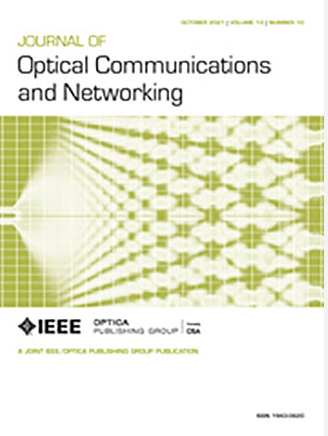Forthcoming optical x-haul infrastructure supporting 6G mobile network requirements
IF 4.3
2区 计算机科学
Q1 COMPUTER SCIENCE, HARDWARE & ARCHITECTURE
引用次数: 0
Abstract
The sixth generation of communication networks necessitates a series of significant technological innovations to accommodate ultra-high rates, ultra-low latency, high energy efficiency, and software-defined programmability for supporting the emerging use cases and the exponential growth in traffic demands. Ultra-wideband (UWB) and spatial division multiplexing technologies have emerged as key enablers in meeting these challenges, offering both scalable network capacity and improved energy efficiency. In this paper, we propose an advanced optical transport architecture designed to fulfill the rigorous performance criteria of next-generation optical networks covering all critical network segments. At the core of this infrastructure—the backhaul segment—we introduce a three-layered UWB/SDM-based multi-granular optical node architecture that utilizes photonic integrated circuit (PIC)-based waveband selective switches, enabling scalable network performance and delivering over 10 Pb/s of flexible optical switching capacity while maintaining a high optical signal-to-noise and interference ratio. At the network edge—the fronthaul segment—we introduce a spatially diverse point-to-multipoint PIC-based optical subcarrier interconnectivity architecture that incorporates a low-loss module—referred to as the interlacer—which interconnects cascaded half-band Nyquist-shaped interleaver filters in order to flexibly perform routing at the subcarrier group level. Across all network segments, we consider innovative, energy-efficient optical digital-to-analog converter-based transceivers capable of achieving transmission rates in the order of terabits per second per channel, while ensuring a small footprint and low power consumption. These transceivers can be flexibly reconfigured to either direct detect or coherent operation, serving the specific needs of the different network segments. Extensive numerical simulations are conducted, with parameters mostly derived from experimental data, to assess the feasibility, scalability, and cascadability of the subsystems that are incorporated to optimize the overall performance of the proposed architecture. Finally, the overall design ensures full compatibility with a service management and orchestration framework, enabling software-defined programmability across all interconnected segments.即将到来的支持6G移动网络需求的光x-haul基础设施
第六代通信网络需要一系列重要的技术创新,以适应超高速率、超低延迟、高能效和软件定义的可编程性,以支持新兴用例和流量需求的指数级增长。超宽带(UWB)和空分复用技术已经成为应对这些挑战的关键推动者,它们既提供了可扩展的网络容量,又提高了能源效率。在本文中,我们提出了一种先进的光传输架构,旨在满足覆盖所有关键网段的下一代光网络的严格性能标准。在该基础设施的核心—回程部分—我们引入了基于UWB/ sdm的三层多颗粒光节点架构,该架构利用基于光子集成电路(PIC)的波段选择开关,实现可扩展的网络性能,并提供超过10 Pb/s的灵活光交换容量,同时保持高光信噪比和干涉比。在网络边缘(前传段),我们引入了一种空间多样化的点对多点基于pic的光子载波互连架构,该架构包含一个低损耗模块(称为interlacess),该模块将级联的半带奈奎斯特形交织滤波器互连,以便在子载波组级灵活地执行路由。在所有网络段中,我们考虑创新,节能的基于数模转换器的光收发器,能够实现每通道每秒兆位的传输速率,同时确保占地面积小,功耗低。这些收发器可以灵活地重新配置,以直接检测或连贯操作,服务于不同网段的特定需求。进行了大量的数值模拟,参数主要来自实验数据,以评估可行性、可扩展性和可级联性,这些子系统被合并以优化所提议的体系结构的整体性能。最后,总体设计确保了与服务管理和编排框架的完全兼容性,使软件定义的可编程性能够跨所有相互连接的部分。
本文章由计算机程序翻译,如有差异,请以英文原文为准。
求助全文
约1分钟内获得全文
求助全文
来源期刊
CiteScore
9.40
自引率
16.00%
发文量
104
审稿时长
4 months
期刊介绍:
The scope of the Journal includes advances in the state-of-the-art of optical networking science, technology, and engineering. Both theoretical contributions (including new techniques, concepts, analyses, and economic studies) and practical contributions (including optical networking experiments, prototypes, and new applications) are encouraged. Subareas of interest include the architecture and design of optical networks, optical network survivability and security, software-defined optical networking, elastic optical networks, data and control plane advances, network management related innovation, and optical access networks. Enabling technologies and their applications are suitable topics only if the results are shown to directly impact optical networking beyond simple point-to-point networks.

 求助内容:
求助内容: 应助结果提醒方式:
应助结果提醒方式:


